
Dry eye is a very common disorder that affects a significant percentage of the population, especially people over the age of 40. Studies vary in their estimations of this percentage, but at least one survey suggests that approximately 20% of people suffer from dry eye syndrome.
Some researchers believe that 75% of the population over age 65 experiences dry eye symptoms. If you suspect that you have dry eyes, you should make an appointment to visit Tyson Eye. We will ask you a number of questions about your symptoms and health history and perform one or more diagnostic tests to determine if you have dry eye syndrome.
Dry eye occurs when the eye does not produce tears properly, or when the tears are not of the correct composition and evaporate quickly. Tear film helps maintain visual sharpness. Other names associated with dry eye include dry eye syndrome, Keratoconjunctivitis sicca (KCS), dysfunctional tear syndrome, lacrimal keratoconjunctivitis, evaporative tear deficiency, aqueous tear deficiency, and LASIK-induced neurotrophic epitheliopathy (LNE).
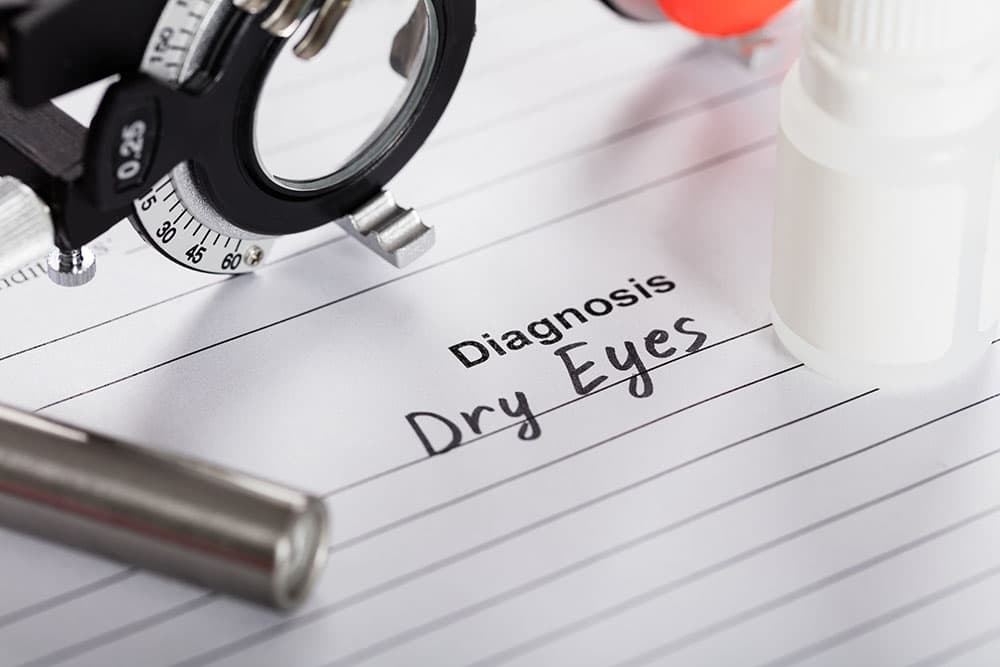
Age, hormone changes (post-menopausal), health conditions, inflammation/infection, trauma/surgery/LASIK.
The sharpness of one’s vision is maintained partly by the tear film, a complex multi-layered fluid structure that helps to provide a smooth surface for light to enter the eye. Three intertwined layers make up the tear film: mucous, aqueous, and oil. The innermost layer, the mucous layer, helps the tears “stick” to the eye. The middle, aqueous or watery layer, contains many proteins and nutrients for the outer surface of the eye. It is the largest layer. The outermost layer, composed of oils or lipids, helps to reduce the evaporation of tears into the air by “sealing” in the other layers.
A healthy tear film serves many vital roles. It provides ocular comfort by keeping the eye lubricated and eliminates friction between the eyelid and the front surface of the eye as it washes away debris. Tears also contain antimicrobial antibodies that defend and provide a protective effect. Many times with a poor tear film, vision can be blurry because the tear film is disrupted, resulting in light scattered away from the eye’s surface. If you find that your vision changes with you blink, your tear film may be the cause of the blurry vision. The name “dry eye” can be a bit confusing as one of the most common symptoms is excessive watering/tearing! It makes more sense when you learn that the eye makes two different types of tears. The first type of tears, called lubricating tears, are produced slowly and steadily throughout the day. Lubricating tears contain a precise balance of mucous, water, oil, nutrient proteins, and antibodies that nourish and protect the front surface of the eye.
The second type of tear, called reflex tears, do not have much lubricating value. Reflex tears serve as a kind of emergency response to flood the eye when it is suddenly irritated or injured. Reflex tears might occur when you get something in your eye, when you’re cutting onions, when you’re around smoke, or when you accidentally scratch your eye. The reflex tears are produced in such large quantities that the tear drainage system can’t handle them all, and they spill out onto your cheek (epiphora).
Still another cause of reflex tearing is irritation of the eye from lack of lubricating tears. If your eye is not producing enough lubricating tears, you can have a type of dry eye syndrome that may be triggering the reflex tears to uncontrollably overproduce.
Abnormalities of the tear film are common and affect a large and diverse population of patients with ocular surface disease. There is now a new term to describe this type of dry eye condition—Dysfunctional Tear Syndrome (DTS). This term calls attention to the fact that many cases of “so-called” dry eye may be from causes other than poor tear production. Instead, research into dry eye has shown that it may be caused by other eye abnormalities and/or disturbances in the tear chemistry. Determining the proper cause of your dry eye is the first and most important step in order to start the proper treatment to improve your eye’s comfort. Your doctor will work with you at any of our seven locations to determine the underlying cause of your dry eye problem, and help you explore the various treatment options available to you.
At Tyson Eye, our outstanding team of doctors is committed to bringing you the latest technology and advances in treatment to help resolve your eye and vision problems. Call us today.
As we get older, glands in the eyelid produce less oil. Decreased oil production allows tears to evaporate too quickly leaving the eye too dry. Diseases including diabetes, Sjogren’s and Parkinson’s, and hormonal changes (especially after menopause) contribute to dry eye syndrome. Some prescription medications, including high blood pressure medications, antihistamines, diuretics, antidepressants, anti-anxiety pills, sleeping pills and pain medications can contribute to dry eye syndrome. The aqueous or watery layer is produced by the lacrimal gland. It is found in the upper eyelid region of both eyes.
The opposite problem – over-production of oils – may result in blepharitis, which may block the flow of oil to the eyes and cause tears to evaporate too quickly.
Due to the complexity and multiple causes of dry eye, patients may have experienced less than successful treatments by doctors in the past. Our doctors have experience in identifying signs and symptoms of dry eye. We have state of the art diagnostic equipment to help identify the specific differences in types of dry eye.
At Tyson Eye our doctors take great pride in the proper diagnosis of dry eye, which is key to formulating an effective treatment plan, implementing that plan, and taking the time to educate our patients on the plan. Our doctors will listen to and answer any and all questions posed by our patients.
We believe taking the time to educate our patients in an open dialogue benefits our patients and helps build a strong physician/patient partnership. The most common treatment plans usually begin by using non-preserved artificial tears or ointments at bedtime. Keeping hydrated by drinking more water can lessen symptoms.
Omega-3 fatty acids have been found to be helpful in the treatment of dry eyes in some people. Lid scrubs, warm compresses, and lid hygiene help with the over production of oil.
After evaluation, your doctor may feel it is necessary to treat you with Restasis®, a prescription drop for dry eyes. Restasis® has been shown to help reduce inflammation causing dry eyes. To conserve your natural tears, your doctor may recommend placing a small plug into the tear drainage system.
Dr. Kaplan has been asked by Allergan to lecture at educational seminars about his successful dry eye treatment program at Tyson Eye.
Dr. Kaplan, at our Cape Coral office, focuses his practice on the treatment of Dry Eye. Since he suffers from dry eye himself, he is especially sensitive to the needs of patients who are experiencing dry eye and have not yet found relief. All of our doctors can also effectively treat dry eye.

The treatment process may be slowed because although one cause is controlled, other contributing causes may not yet have been identified. An open dialogue with the doctor and the patient’s participation is essential in determining the causes of dry eye and which combination of treatments will provide successful relief of symptoms.
The Schirmer’s test is used to determine whether your tear glands produce enough tears to keep your eyes adequately moist. Calibrated strips of a non-toxic filter paper are used. One free end is placed next to your lower eyelid. Both eyes are tested at the same time. Before the test, you may be given numbing eye drops to prevent your eyes from tearing due to irritation from the paper. You will be asked to keep your eyes gently closed for 5 minutes.
At the conclusion of the test, the paper strips are removed from each lower eyelid and the amount of wetting of the paper strips is measured. Wetting of less than 5 mm is indicative of deficient tear production, but is not necessarily diagnostic of Sjogren’s syndrome. The results need to be correlated with other findings on the eye exam in order to determine if you have a dry eye syndrome.
Research has shown that Omega-3 (OM-3) fatty acids are helpful for dry eyes. Omega-3s are essential building blocks for the body. They are “essential” because the body cannot create them on its own, but needs to acquire them through diet.
In the U.S., many people do not eat enough foods that naturally contain these building blocks. Some Omega-3s (DHA and EPA) can be acquired by eating two to three servings per week of the oily cold-water fishes, such as anchovies, salmon, albacore tuna, herring, halibut, mackerel, and sardines. Plant foods rarely contain EPA or DHA. There is also another type of OM-3 (ALA) that is found primarily in dark green leafy vegetables and flaxseed oils. ALA can be partially converted to EPA and DHA in the body. Eat spinach, broccoli, brussels sprouts, garlic, peas, and cauliflower.
Without a sufficient supply of Omega-3, the body will use other fats to construct cells. These cells may be less elastic and have a negative effect on the heart, so many cardiologists and primary care doctors are prescribing Omega-3 for the heart and to reduce cholesterol.
Many people choose a relatively fat-free diet to avoid weight gain, but in doing so eliminate the needed Omega-3 fatty acids. OM-3s are natural blood thinners, so you need to check with your primary care physician before starting this therapy, especially if you are currently taking a blood thinner like Coumadin or aspirin. It may take two to three months to see any changes in dry eye symptoms on this regimen.
Fish oil supplements sometimes cause stomach or digestive problems, so they should be taken with food. Flaxseed oil is used as an alternative because of its milder taste. Flaxseeds or flaxseed oil can be easily mixed with salads, cereals, and smoothies, however, some people do not metabolize the OM-3 from flax seeds easily. Eating walnuts is also helpful.
To avoid “fish burps” when taking fish oil, purchase enteric coated fish oil tablets. We recommend 2,000 mg or more daily.
If your dry eye symptoms can be alleviated through modification of your diet, it is a less invasive, more natural treatment and will probably lead to a healthier lifestyle in general. Some of our patients who also experience dry sinuses, dry mouth and dry skin are very pleased with their results after a couple of months on Omega-3 therapy, and appreciate the other benefits like reduction of inflammation.
Your doctor’s primary treatment intervention for dry eye syndrome is usually an artificial tear supplement that can temporarily restore moisture to the eyes and may be purchased over-the-counter. These products are gentle on your eyes and are highly recommended over other products advertised to “get the red out.” Those other products may actually worsen your dry eye condition due to the chemicals and preservatives used in these formulations. They are developed specifically to “get the red out” instead of lubricating dry eye exclusively.
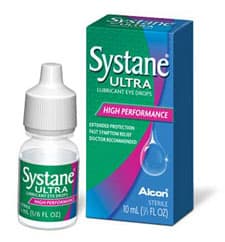
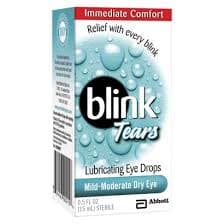
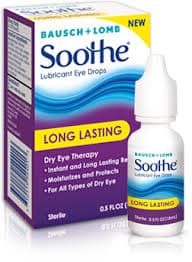
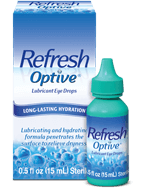
Tips on Tear Supplement Use:
If your dry eyes also have flaking along the eyelids, you could have Blepharitis, a dandruff-like inflammation of the eyelash follicles caused by the over production of oil that can block the glands. Eyelid problems such as Blepharitis, Meibomianitis, and Rosacea affect the outer oily layer of the tear film, causing excessive evaporation of the natural tears from the eye.
Many of these eyelid disorders may be relieved with the use of daily eyelid hygiene. Hot compresses and lid scrubs are used to keep the eyelids free of the excess oil build-up that may block the flow of oil to the eyes. Some lid scrubs, such as Ocusoft and SteriLid Scrub, can be purchased over-the-counter. Washing eyelids with baby shampoo may also be recommended for some patients.
One type of chronic dry eye is caused by decreased tear production due to inflammation. The tear film protecting the eye can break down, creating dry spots on the surface of the eye. Restasis™ is an approved prescription-strength treatment for dry eye that contains the drug cyclosporine. This is the first prescription drop which has the potential to address the underlying disease mechanisms rather than the symptoms alone. Restasis™ helps to stop the inflammation that may cause dry eyes in some patients.
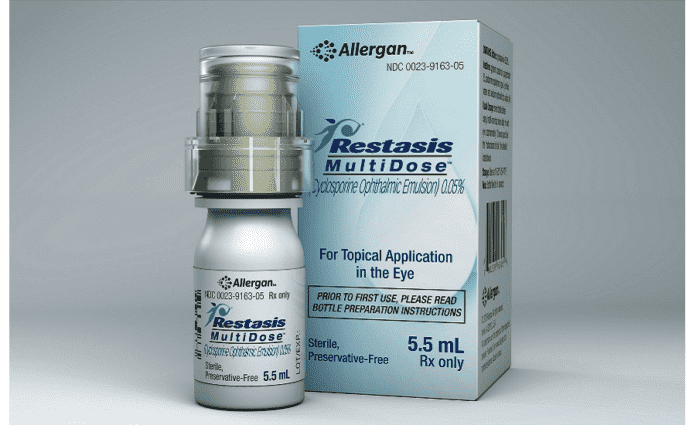
Once your tears have been evaluated, your doctor will tell you if Restasis™ will be a good option for you. If prescribed, it can take several months to see the full effect, although some improvement may be seen as early as one month. It is usually used twice a day, and is the only prescription eye drop that increases tear production.
In a properly tear-balanced eye, there is feedback from the eye to the brain to help maintain a normal functioning tear film. Dry Eye disease can be inflammatory in nature, which can disrupt this feedback. When the eye is exposed to an irritant, an immune reaction occurs. T-cells, a type of white blood cells, are then triggered during this immune reaction, and as a result trigger other immune factors called cytokines. Cytokines disrupt the feedback from the eye to the brain, and inflammation occurs. A complex of normal circulating hormones maintains the ocular surface in a non-inflamed state. Aging and menopause lead to reduced circulating levels, which leads to reduced protection from inflammation. Restasis™, a prescription treatment for dry eye, reduces the inflammation.
Tears drain out of the eye through small openings in the lids called puncta. A small “plug” may be inserted into one of two holes to prevent the tears from draining out of the eye and keep natural tears in your eyes longer.
The punctal plug can be removed if necessary. It is a semi-permanent way to treat dry eyes. Medicare and most commercial insurance plans pay for this in-office procedure. Your doctor has a wide choice of punctal plug brands to choose from and will select the one that is best for your particular situation.
During the in-office procedure, the plugs are painlessly inserted into the puctum by the doctor with a small instrument. The punctal plugs are greatly enlarged before they are inserted into the eye. Punctal plugs, while not for every patient, are a welcome solution to help relive dry eyes.
Need help? Reach out to us today at 239-542-2020.
The material contained on this site is for informational purposes only and is not intended to be a substitute for professional medical advice, diagnosis, or treatment.
Always seek the advice of your physician or the other qualified health care provider.